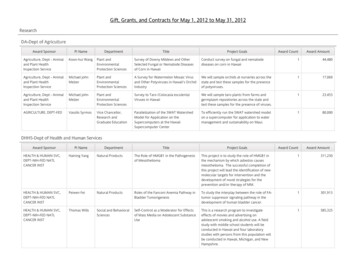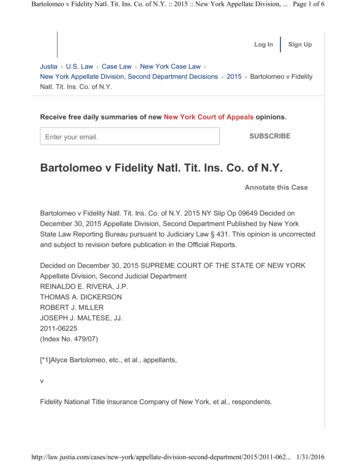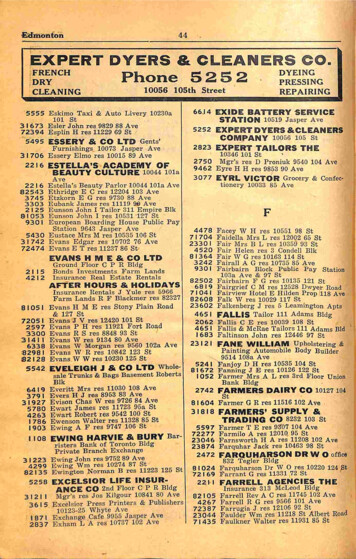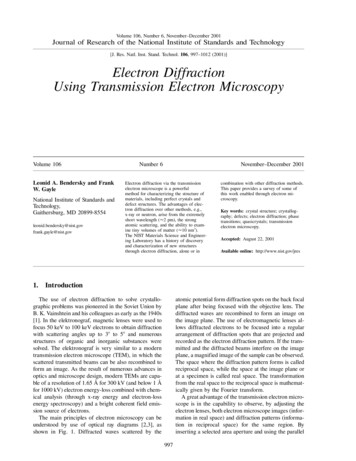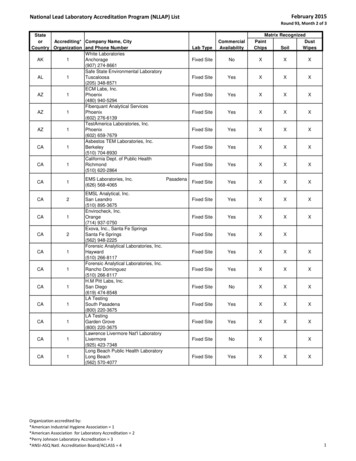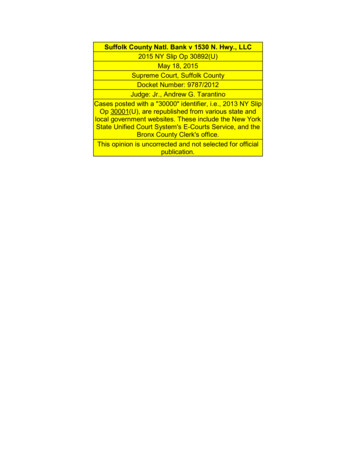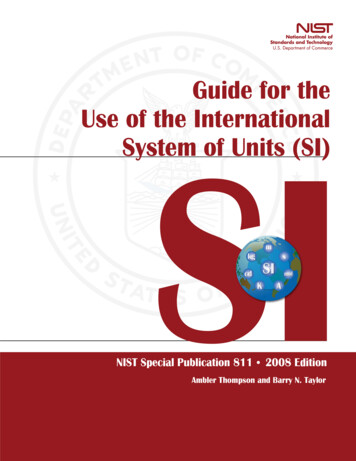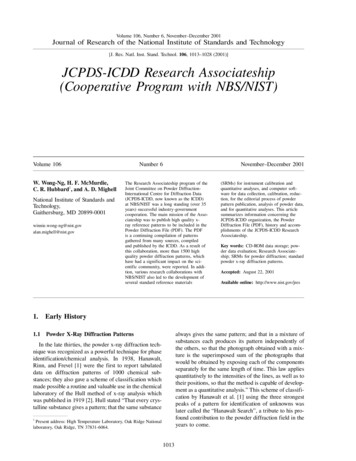
Transcription
Volume 106, Number 6, November–December 2001Journal of Research of the National Institute of Standards and Technology[J. Res. Natl. Inst. Stand. Technol. 106, 1013–1028 (2001)]JCPDS-ICDD Research Associateship(Cooperative Program with NBS/NIST)Volume 106W. Wong-Ng, H. F. McMurdie,C. R. Hubbard1, and A. D. MighellNational Institute of Standards andTechnology,Gaithersburg, MD .govNumber 6November–December 2001The Research Associateship program of theJoint Committee on Powder DiffractionInternational Centre for Diffraction Data(JCPDS-ICDD, now known as the ICDD)at NBS/NIST was a long standing (over 35years) successful industry-governmentcooperation. The main mission of the Associateship was to publish high quality xray reference patterns to be included in thePowder Diffraction File (PDF). The PDFis a continuing compilation of patternsgathered from many sources, compiledand published by the ICDD. As a result ofthis collaboration, more than 1500 highquality powder diffraction patterns, whichhave had a significant impact on the scientific community, were reported. In addition, various research collaborations withNBS/NIST also led to the development ofseveral standard reference materials1.Early History1.1Powder X-Ray Diffraction Patterns(SRMs) for instrument calibration andquantitative analyses, and computer software for data collection, calibration, reduction, for the editorial process of powderpattern publication, analysis of powder data,and for quantitative analyses. This articlesummarizes information concerning theJCPDS-ICDD organization, the PowderDiffraction File (PDF), history and accomplishments of the JCPDS-ICDD ResearchAssociateship.Key words: CD-ROM data storage; powder data evaluation; Research Associateship; SRMs for powder diffraction; standardpowder x-ray diffraction patterns.Accepted: August 22, 2001Available online: http://www.nist.gov/jresalways gives the same pattern; and that in a mixture ofsubstances each produces its pattern independently ofthe others, so that the photograph obtained with a mixture is the superimposed sum of the photographs thatwould be obtained by exposing each of the componentsseparately for the same length of time. This law appliesquantitatively to the intensities of the lines, as well as totheir positions, so that the method is capable of development as a quantitative analysis.” This scheme of classification by Hanawalt et al. [1] using the three strongestpeaks of a pattern for identification of unknowns waslater called the “Hanawalt Search”, a tribute to his profound contribution to the powder diffraction field in theyears to come.In the late thirties, the powder x-ray diffraction technique was recognized as a powerful technique for phaseidentification/chemical analysis. In 1938, Hanawalt,Rinn, and Frevel [1] were the first to report tabulateddata on diffraction patterns of 1000 chemical substances; they also gave a scheme of classification whichmade possible a routine and valuable use in the chemicallaboratory of the Hull method of x-ray analysis whichwas published in 1919 [2]. Hull stated “That every crystalline substance gives a pattern; that the same substance1Present address: High Temperature Laboratory, Oak Ridge Nationallaboratory, Oak Ridge, TN 37831-6064.1013
Volume 106, Number 6, November–December 2001Journal of Research of the National Institute of Standards and Technology1.2Formation of the JCPDSdraws its Board of Directors, committees, and subcommittees. The members, who are volunteers, are activelyengaged in developing the field of x-ray powder diffraction and related disciplines. They gather twice annuallyto discuss various technical issues related to powderdiffraction methods, and editorial issues related to thePDF, and to organize, plan, and review policies andprocedures within the ICDD organization. The Technical Committee consists of three categories of subcommittees, namely, Materials Subcommittee (Ceramics,Minerals, Metals and Alloys, Organic and Pharmaceutical and Polymer), Characterization Methods & ToolsSubcommittee (Electron Diffraction, Synchrotron Diffraction Methods, X-Ray Diffraction Methods, X-RayFluorescence, High Pressure and High Temperature Diffraction, and Neutron Powder Diffraction), and ICDDActivities Subcommittee (Database, Education and PDFEditorial Staff). A paid scientific and administrativestaff, located at the headquarters in Pennsylvania, isresponsible for the production of the various databasesoffered by the ICDD.The ICDD financially supports scientific activitiesworldwide. Amongst these activities, it maintains aGrants-in-Aid program in order to provide high qualitydata and develop search techniques for the identificationof materials by powder diffraction methods. In the areaof education, the ICDD “has established a Crystallography Scholarship Fund, now known as the Ludo FrevelCrystallography Scholarship Fund.” The function of thisfund is “to encourage promising graduate students topursue crystallographically oriented research.”In the late 1930s, a meeting was held at Gibson Island, MD to discuss the formation of an ongoing file ofx-ray powder diffraction patterns of chemical phases foruse in identifying materials. This meeting was arrangedby Wheeler P. Davey of Pennsylvania State College.Herbert Insley and Howard McMurdie were invited tothe meeting as NBS was known to have a growing interest in the subject. In 1941, the Joint Committee onChemical Analysis by X-Ray Diffraction Methods, partof the American Society for Testing and Materials(ASTM), was founded. This committee, which was alsosponsored by the British Institute of Physics, askedDavey to direct an extensive project to coordinate research and publication activity of the diffraction patterns worldwide [3,4]. This activity called upon numerous leaders in the x-ray diffraction field to categorize acollection of cards with information pertaining to powder x-ray diffraction patterns. Howard McMurdie wasasked to represent NBS. For several years the size of thecommittee expanded, and its members met at Pennsylvania State University on a regular basis. Later the chairman for the committee was J. V. Smith, also from PennState.ASTM published the first set of data, consisting of4000 cards in 1941, covering some 1300 compounds.An extensive set of some 4500 supplement cards wascompleted around 1945. These cards contained data forinorganic, organic and mineral crystalline phases andincluded interplanar spacings, relative intensities, and,when available, indexing, unit cell, specific gravity, andoptical property data.The purpose of this committee was to collect, edit,publish, and distribute primary references for x-raypowder diffraction analysis/identification of crystallinematerials. This compilation is now commonly known asthe Powder Diffraction File (PDF). Many scientificassociations and societies, including the ASTM, supported the initial effort. Continued additions and regularpublication of “sets” followed. By 1969, the committeewas constituted as a Pennsylvania nonprofit corporationunder the title of the Joint Committee on Powder Diffraction Standards (JCPDS). In 1978, the currentname—International Centre for Diffraction Data—wasadopted. The ICDD Mission Statement is “The International Centre for Diffraction Data will continue as theworld center for quality diffraction data to meet theneeds of the technical community, ICDD promotes theapplications of materials characterization methods inscience and technology by providing a forum for theexchange of ideas and information.”Today, nearly 300 international scientists from industrial, academic and governmental laboratories comprisethe active membership from which the organization1.3Formation of the JCPDS-Associateship at NBSIn the late forties, there was considerable criticismabout duplicate patterns on some phases which were notalways consistent as they were made by different methods , and there was always a call for coverage of morecompounds. For example, at a meeting of the AmericanCrystallographic Society in 1948 a prominent crystallographer called for the whole file to be redone. It wasrecognized that there was a need for an organized scientific group to undertake a systematic review of the file,and to prepare quality powder diffraction reference standards. Although many of the patterns obtained from theliterature and other sources were adequate, there was aneed was to prepare data using reproducible, controlledconditions of specimen preparation and the best recording instrumentation available. Under the sponsorship ofthe ASTM, the Joint Committee on Chemical Analysisby X-Ray Diffraction Methods of the ASTM, A.S.X.R.E.D., and British Institute of Physics, a Research Associateship was established at NBS, effective July 18,1949 [4].1014
Volume 106, Number 6, November–December 2001Journal of Research of the National Institute of Standards and TechnologyThe Research Associateship was under the direct supervision of H. F. McMurdie, then Chief of the Constitution and Microstructure Section of the Division of Mineral products, and members of this special group wereappointed by the JCPDS-ICDD, consisting of ChairmanW. L. Fink (Aluminum Company of America), L. L.Wyman (General Electric Co.), W. P. Davey, and L. K.Frevel (Dow Chemical Co.). Eleanor Tatge was namedto the Associateship. Her primary responsibility was toreview conflicting data in the card file issued by theJoint Committee and undertake the selection of correctpatterns or to make new patterns of standard materialAfter McMurdie’s retirement, he was appointed by theJCPDS-ICDD to be the main contact with ICDD and H.Swanson became the principal scientist. In 1976 Marlene Morris became the contact and principal scientist.In the early seventies, Camden Hubbard of NBS wasappointed as the liaison officer between the Associateship and NBS. He provided distinguished leadership inensuring the quality of the patterns, as well as keepingabreast with the state-of-the-art computer technologyand x-ray diffraction instrumentation and techniques.The members of the Associateship from the beginning to its conclusion in 1986, included (alphabeticalorder): Simon J. Carmel, Eloise H. Evans, Ruth K.Fuyat, Nancy T. Gilfrich, Donna M. Gladhill, Johan H.de Groot, Kimberly Hill, Camden R. Hubbard, HowardF. McMurdie, Marlene C. Morris (Cook), Boris Paretzkin, Harry S. Parker, Nikos P. Pyrros, Eleanor Tatge,Roger P. Stinchfield, Howard E. Swanson, George M.Ugrinic, Linda Ulmer, and Winnie Wong-Ng. A fewphotographs of these members and outside colleaguesare shown in Figs. 1 to 4.Fig. 1. Photo of the early diffractometers (seventies and early eighties) and strip-chart recorders used to collect powder diffraction patterns.Howard McMurdie is shown in the front and Boris Paretzkin (deceased) in the back.1015
Volume 106, Number 6, November–December 2001Journal of Research of the National Institute of Standards and TechnologyFig. 2. Members of the JCPDS Associateship with members of the JCPDS Board of Directors. (From left to right, front row: Eloise Evans, BorisParetzkin, Mary Mrose, Winnie Wong-Ng; back row: Julian Messick (general manager of JCPDS), James Edmond (JCPDS member of BOD),Howard McMurdie, Marlene Morris, Harry Parker, Gregory McCarthy (JCPDS member of BOD), Deane Smith (JCPDS Chairman of BOD), andCamden Hubbard (NBS/JCPDS Liaison).2.The Powder Diffraction File (PDF)various experts of the field. Subfile mark assignmentwas also conducted by the editors. The careful editorialprocess assures that the ICDD maintains the higheststandards for accuracy and quality of its database [8].The PDF currently (2001 release) consists of 51 setsof data and 136 895 patterns (over 87 500 experimentaland 49 000 patterns calculated from the ICSD (ICSD isthe Inorganic Crystal Structure Database maintained byFachsinformationzentrum (FIZ) in Karlsruhe andNIST). The file covers ceramic mineral, metal/alloy, organic and other inorganic crystalline materials. ThePDF is subdivided into various subfiles, such as inorganic, mineral, organic, metal/alloy, common phases,ICSD, forensic, education, zeolite, explosive, superconductors, cement, corrosion, polymer, detergent, pigment, pharmaceutical, ceramics, and a separate subfilefor the NBS patterns.In the early days, the PDF [5] database was availableon 3 5 inch card sets and microfiche sets, with accompanying Alphabetic, Hanawalt, and Fink SearchManuals. Periodically several sets are re-edited and published in bound volumes. A subset of the PDF databasewas made available for search/match on magnetic tape.Many intermediate editorial and technical procedureswere used to maintain quality, accuracy, and completeness of the database. In 1976, the JCPDS recognized theneed to convert to a computer data base [6,7]. Moredetails of the computerization process will be describedbelow.Powder diffraction patterns are compiled from journals, the ICDD Grant-in-aid Program, other grants andscientific contributions. The patterns are edited for correctness, and reviewed for quality and uniqueness by1016
Volume 106, Number 6, November–December 2001Journal of Research of the National Institute of Standards and TechnologyFig. 3. In 1986, the mission of the JCPDS/NBS collaboration was accomplished. This photo shows the Associateship members receiving acertificate of accomplishment from the NBS Deputy Director (later Director), Ray Kammer. From left to right, front row: Howard McMurdie, BorisParetzkin, Eloise Evans, Winnie Wong-Ng; back row: Ray Kammer, Marlene Morris, Kimberly Kessell (Hill), and Camden Hubbard.3.Collaborative Projects of the JCPDSICDD Research Associateship3.1Preparation of Standard Reference PatternsThese NBS standard patterns were produced usingreproducible, controlled conditions of specimen preparation, and the best recording methods and instrumentation available. The method of producing these patternshas been described in detail by McMurdie et al. [9]. Theconsistently high quality of these patterns has been anintegral part of the Powder Diffraction File (PDF). Thedirective of the JCPDS Associateship at NBS to prepareaccurate data for the important inorganic substances hasresulted in upgrading patterns already represented in thePDF as well as the addition of many new patterns fromsubstances for which no data were available. Table 1 isan example of a NBS produced pattern for Au (PDF4-784) prepared in year 1953. After all these years, it isstill a sought-after standard, and is the only pattern forthis material. The high quality of the data has shown towithstand the test of time.The primary mission of the JCPDS-ICDD ResearchAssociateship was to produce standard reference x-raypowder diffraction patterns for phase identification.Several additional research projects which were important for improvement of the quality of patterns andmethodology were also identified and conducted underthe supervision of the NBS scientific staff. Theseprojects included the development of computer softwarefor data collection and reduction, software to aid thepowder pattern evaluation and editorial process, andquantitative phase analysis. Another area of importantresearch area was the development of standard referencematerials (SRM ) for instrument calibration and quantitative phase analysis.1017
Volume 106, Number 6, November–December 2001Journal of Research of the National Institute of Standards and TechnologyFig. 4. Howard McMurdie receiving the 2000 Barrett Award from the Chair of the Boardof Director, Camden Hubbard.1018
Volume 106, Number 6, November–December 2001Journal of Research of the National Institute of Standards and TechnologyTable 1. JCPDS/NBS powder diffraction pattern of Au (4-784), reproduced with the permission of the ICDDThe patterns prepared by the NBS Associateshipwere used for various applications. For example, theyhave often been singled out for reference when testingnew methods involving x-ray diffraction. Also, as a finalstep in the alignment of any x-ray powder diffractioninstrument, it is a common practice to record the patternof some common materials, e.g., SiO2 (quartz), Al2O3(corundum) etc., and to compare them against the reference patterns produced by the Associateship. In lateryears, with the introduction of computer-controlled experimental systems, and with the computer-basedsearch-match procedures, this testing became more intensive. During the development of computer unit cellindexing routines, it was further recognized that onlyhigh quality data such as the Associateship patternswould consistently yield correct results.Because of the extraordinary quality of the patternsproduced by the Associateship, they have been collectedunder a single cover known as the NBS Patterns. Thiscollection contains patterns for many compounds commonly encountered in scientific and industrial studies.Although these patterns have appeared in Circulars andMonographs published by the NBS, several of thesepublications were out of print at the time the NBS Patterns Book appeared. Also, earlier patterns have beenrevised as new techniques became available. A minifilecalled ‘NBS’ subfile was created in the PDF database,and these patterns also served as a minisearch file alongwith a specific search manual. The NBS patterns havealso been used as an excellent teaching tool in the use ofpowder diffraction methods for compound identification. (The full PDF with a large number of patterns1019
Volume 106, Number 6, November–December 2001Journal of Research of the National Institute of Standards and Technologyoften led the beginners into many confusing patternsimilarities.) These data cover many common laboratory chemicals and minerals so that in some cases identifications of common materials can be made quicklywithout a search through the full data collection. Teachers in classrooms often have found this minifile usefulbecause most of the materials reported are readily available for classroom experiments.In order to obtain a basis for an approximate quantitative analysis of mixtures, a comparative strength of peakheight intensities from different materials is necessary.In addition to the crystallographic data, d -spacings, intensity values of the diffraction peaks, references, sample preparation procedure, another piece of informationwhich is reported for a large number of patterns prepared by the Associateship is the reference intensityratio (RIR). RIR is an instrument-independent constantfor use in the quantitative phase analysis by the internalstandard method [9a,10]. These constants can be measured or calculated. The choice of the best material touse as a standard was made by cooperations betweenNBS, Laboratorium voor Technische Natuurkunde, andTechnisch Physische Dienst, and the JCPDS ResearchAssociateship. A small particle size material corundum, -Al2O3, was chosen as the internal standard for preparing the reference intensity ratio (RIR). When the reference standard is corundum, RIR is known as the I /Ic.Recommended methods for accurate measurement ofRIR constants were discussed by Hubbard and Snyder[10].3.23.3Development of Standard Reference Materials(SRM)Based on the NBS/JCPDS collaborations, severalstandard reference materials (SRMs) were developed forpowder x-ray diffraction measurements [13-15]. Amongvarious SRMs developed by C. R. Hubbard and hiscoworkers, two were developed specifically to improvethe quality of the PDF data. SRM 640 (640a and 640bwere renewals) [14,15] were high-purity silicon powders that were prepared from electronic grade float-zonesilicon boules. Recently SRM640c was certified by J. P.Cline et al. [16]. This standard was also prepared fromultra high purity, intrinsic silicon boules that werecrushed and jet milled. The certification was conductedusing a diffractometer built at NIST for that purpose andanalyzed using a Fundamental Parameter Approachconvolution algorithm [17]. SRM 675 is synthetic fluorophlogopite mica with initial diffraction peaks at muchlower 2 than those from Si [18]. They were used tocorrect for shifts of peak positions arising from sample,instrument, and physical aberrations. SRM 675 is intended for use as a low angle (large d -spacing) standardand is best used as pressed samples having a high degreeof preferred orientation in which the 00l reflections havesignificant intensity. Both these SRMs were d -spacingstandards which can be used as external or internalcalibrants and are in high demand. External and internalstandard calibration are important procedures forachieving high accuracy in x-ray powder diffractionstudies. The theoretical basis as well as procedures forobtaining calibration curves, methods and examples ofselecting SRMs, and procedures of sample preparationwith these standards are described by McMurdie et al.[9] and Wong-Ng and Hubbard [19]. Other standardsproduced at NBS by Hubbard and colleagues during the1980s include SRM660 (LaB6) for profile calibration,SRM 674 (a suite of 5 RIR calibrants consisting ofcorundum, fluorite, alumina, rutile, wurtzite), and SRM1878 (respirable quartz).Today a large collection of SRMs is available for powder x-ray diffractometry. Further development of newSRMs as well as recertification of existing ones continues under the leadership of J. P. Cline. He has developeda new SRM 1976 (alumina plate) and recertified three(SRM 660a, SRM 640c, and SRM 1878a) whose stockwas exhausted. Their purpose, cost, and further information on these SRMs are available in the SRM officeof NIST. Further information can be obtained via theWebsite (http://www.nist.gov/srm).Automation of Data Collection and ReductionThe production of standard x-ray diffraction patternsat NBS imposed special requirements and specific demands in the automated data collection and data processing. The data collection system AUTO [11] and thedata processing system POWDER-PATTERN [12],which was a flexible and an interactive data processingsystem, were developed in the early eighties. The POWDER-PATTERN suite consisted of a number of independent programs. These independent programs includePATTERN (locate peaks by smoothing data and calculating the second derivative), CALIBRATE (correct the2 values using internal and/or external calibrationparameters), PLOT (perform both hardcopy and interactive plots), and PROFILE REFINEMENT (refined peakpositions and their intensities). This software suite wascritical for the Associateship members to generate highquality x-ray diffraction patterns. Many requests havebeen received from outside laboratories concerning theavailability of these software products.1020
Volume 106, Number 6, November–December 2001Journal of Research of the National Institute of Standards and Technology3.4Computerization of the ICDD PowderDiffraction Databaseof a variety of new classes of material, and the state-ofthe-art computer database and file structure. It still remains as the key editorial program for producing thePDF. Because of this sophisticated computer program,the review process utilized today is considerably morestringent than in former years [8]. Because of the important impact of this program on the evaluation of diffraction data as well as deriving various ICDD products, adetailed description of the NBS*AIDS83 program isgiven as an appendix.The full-scale project of computerization and criticalevaluation of PDF data Sets 1-32 was initiated in thebeginning of 1982. All data entering the PDF beginningwith data for Set 33 were not part of the historicalreview but were evaluated and computerized during theeditorial and publication process. Since 1984, productssuch as data books and data cards (discontinued to date)have been produced directly from the PDF database.Today, all PDF products are generated directly from thedatabase, including a recently released relational database product. Further information about the ICDD products can be located at the WEBSITE: http://www.icdd.com.Computerization of the PDF has been a significantundertaking, beginning in 1979 and substantially complete in 1985 [6,7]. The main goal of this undertakingwere:1. To enhance the quality of the PDF,2. To increase the efficiency of the data entry, dataediting, data review and record keeping.3. To simplify the production efforts by eliminating theneed to maintain the database in two separate forms.4. To eliminate problems such as incompleteness ofdata and rounding of d -spacings on the PDF tape.5. To have a more flexible and informative database.6. To enhance the assessment of quality of the data.7. To evaluate all patterns with computer-assisted methods.In 1976, G. J. McCarthy, Chairman of the TechnicalCommittee of ICDD, established a task group, whichsubsequently became the Data Base Subcommittee(chaired by C. R. Hubbard). A proposal which entaileda five year plan of creating computer code, designingand testing a prototype database, and reevaluating thehistorical data of Sets 1-32 was submitted by this subcommittee and was approved by the ICDD Board ofDirectors. The computerization was carried out cooperatively by both the ICDD and NBS staff. The NBS staffprovided the technical guidance for the entry processand wrote the key computer programs which were necessary for the creation and critical evaluation of thecomputer database. Members of the ICDD staff performed the critical review, developed editorial procedures, and provided additional data entry. Work on theproposal began at NBS with the design of the databaseformat (structure of the database), selection of dataitems to be included, and development of a computerprogram to evaluate the data entries. The format selected for the PDF database was that of NBS CRYSTALDATA [20] developed by NBS Crystal Data Center [21]and expanded to include powder pattern information. Acomputer program, known as the NBS*AIDS80 [22],was designed to build and evaluate a database entry. Thelater version of the program is known as theNBS*AIDS83.If NBS*AIDS80 finds a data or format inconsistency(“error”), then the data must be corrected and reprocessed. Patterns with unresolvable errors were added toa list of questionable phases for remeasurement. Theprogram also gives warnings of possible errors in thedata, each of which are reviewed, and, if necessary,editorial changes are made. Throughout the years, thisprogram has been updated extensively to meet the need3.5Compact Disk Read Only Memory (CD-ROM)System for Data StorageAnother development of the ICDD database concernsdata storage using a CD-ROM disk. In the mid-eighties,there was increasing use of the PDF in computer readable form, but the limited amount of disk space availableon most commercial powder diffractometer systemslimited the use to a small subset of the total PDF. Aproduct proposal was submitted by W. Wong-Ng and C.Hubbard to the JCPDS-ICDD Board of Director in theearly eighties, followed by several presentations concerning the advantages and various product opportunities of using the state-of-the-art CD-ROM technology.The availability of low-cost CD-ROM systems offeredan attractive alternative to conventional disk media [23].Under the guidance of R. Jenkins, then ICDD PrincipalScientist, the concept of a low-cost Personal Computer/CD-ROM system, “PC-PDF”, having a total availablestorage of 550 MB, was developed in the late eighties.A variety of search strategies were developed that arebased on PDF numbers, chemistry, strongest d -spacings, etc. By use of optimum packing and access algorithms, the various searches operated at speeds highlyconvenient to the user. Currently, the CD-ROM productsare the most popular products by ICDD.1021
Volume 106, Number 6, November–December 2001Journal of Research of the National Institute of Standards and Technology4.Advanced Ceramic Reference PatternProgram at NBS (1986-1989)terials for thin film applications. All of these fields aredeveloping rapidly. The availability of high-quality powder patterns of carefully-prepared and well-characterized materials will meet the expressed needs of researchers in these fields.In collaboration with J. Kaduk of BP-Amoco Research Center, patterns were analyzed using the Rietveldrefinement technique [25]. Data processing was performed using the General Structure Analysis System(GSAS) [26]. The peaks are located by LeBail extractions of the raw patterns, using pseudo-Voigt profilefunctions. The internal standard results in correctionsfor systematic errors, principally sample displacementand transparency. Crystallographic cells, if unknown,were determined using the ITO [27] and/or Boultif &Louer [28] indexing programs. The reported latticeparameters were determined from profile fits. Refinements of the crystal structures are used to analyze andconfirm details of the space group symmetry.With the development of standards, software, automated systems and numerous publications of data andmethods, more and more laboratories became capable ofmeasuring and analyzing high quality reference patterns. Thus, the mission of the ICDD Research Associate Program was believed to be accomplished in 1986,and part of the staff of the ICDD Associateship wastransferred to the ICDD Headquarters. Following thissuccess, a 3-year program at NBS to produce high quality x-ray patterns of important ceramic phases was established. This program was administered by C. R. Hubbard and A. L. Dragoo, with W. Wong-Ng was in chargeof the day-to-day operation. The project was directedtoward the production of x-ray diffraction data for important ceramic phases, which might find applicationsin engine components, cutting tools, etc. This projectwhich was an integral part of the program at NBS todevelop measurement methods and data to further themanufacture and use of ceramic materials, included acomprehensive review and upgrade of data for selectedborides, carbides, silicides, nitrides, oxynitrides, selenides, tellurides and oxides. Samples for x-ra
Journal of Research of the National Institute of Standards and Technology [J. Res. Natl. Inst. Stand. Technol. 106, 1013-1028 (2001)] JCPDS-ICDD Research Associateship (Cooperative Program with NBS/NIST) Volume 106 Number 6 November-December 2001 W. Wong-Ng, H. F. McMurdie, C. R. Hubbard1, and A. D. Mighell National Institute of Standards .

